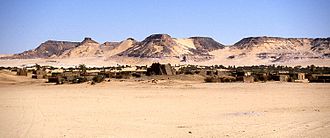Séguédine
Séguédine (in Tuareg Berber Sǝggǝdǝm , alternative spellings Siguédine and Siguidine , in German sources also Segedin or - scientifically correct - SSigedim or Siggedim ) is a small oasis with about 380 inhabitants (as of 2012) in the Kaouar Valley north of the Ténéré desert in East of the Republic of Niger . The place is 417 m above sea level on the coordinates 20.19485 ° N and 12.96086 ° E.
Siggedim is located on the eastern foothills of the Pic Zoumri ( 576 m ), north of the Kawar oasis, about 180 kilometers north of Bilma. In 2001 Séguédine had 484 inhabitants. The village has a school, a health center and a drug store. The houses are mostly made of adobe bricks . Sights include a ruined fortress.
Séguédine is mentioned as early as the 9th century in the works of Arabic writers. It was an important place for the caravan trade on Bornus Road , the most important north-south route through the Sahara. The inhabitants of the place were originally Kanuri , later Tubu were added or displaced the Kanuri. The village was temporarily abandoned in the 18th century as a result of raids by Tuareg and Tubu. The French suffered losses in the 1920s when they drove the Tubu from Séguédine.
The place is east-northeast of the witness mountain Pic Zumri with the best quality salt in the Kaouar valley . Salt production in Séguédine resumed in 1941 when the residents of the village returned from Emi Tchouma . The salt preparation is carried out in the same manner as in Bilma or Fachi in evaporation ponds . Séguédine salt is of excellent quality, but production is now low because the place is too remote for the salt caravans . The caravans prefer to visit the salt oases of Fachi or Bilma, which are closer along the southern Aïr- Bilma route. Only Libyan truck drivers entering or passing through Niger occasionally take a few sacks of dates or salt with them. Accordingly, the inhabitants lack opportunities to earn money and trade (millet for salt and dates). Séguédine is a starting point for trips to the medieval ruined city of Djado, 140 km to the northwest .
The village had 188 people at the 1988 census, 485 people at the 2001 census, and 381 people at the 2012 census.

Séguédine is a main setting in the 1954 novel La vallée de sel by Louis Carl and Joseph Petit, in which a family story from the 18th century to the 1950s is described.
literature
- Albert Le Rouvreur: Une oasis au Niger: le Djado . L'Harmattan, Paris 1999, ISBN 2-7384-7860-3 (French).
- Knut S. Vikør: The oasis of salt. The history of Kawar, a Saharan center of salt production . Center for Middle Eastern and Islamic Studies, Bergen 1999 (English).
Individual evidence
- ↑ Karl-G. Prasse, Ghoubeïd Alojaly, Ghabdouane Mohamed: Dictionnaire Touareg - Français (Niger): M – Ž . Museum Tasculanum Press, Copenhagen 2003, ISBN 87-7289-844-5 , p. 705 (French).
- ↑ Recensement Général de la Population 1988: Répertoire National des Villages du Niger . Bureau Central de Recensement, Ministère du Plan, République du Niger, Niamey March 1991, p. 35 (French, ceped.org [PDF; accessed January 31, 2018]). www.ceped.org ( Memento of the original dated January 31, 2018 in the Internet Archive ) Info: The archive link was inserted automatically and has not yet been checked. Please check the original and archive link according to the instructions and then remove this notice.
- ^ Répertoire National des Communes (RENACOM). (RAR file) Institut National de la Statistique, accessed November 8, 2010 (French).
- ↑ Répertoire National des localites (ReNaLoc). (RAR) Institut National de la Statistique de la République du Niger, July 2014, p. 8 , accessed on 7 August 2015 (French).
- ^ Daniel Mignot, Jean-Dominique Pénel: Le Niger dans la littérature française . In: Marie-Clotilde Jacquey (ed.): Littérature nigérienne (= Notre librairie . No. 107 ). CLEF, Paris 1991, p. 27 (French).
Coordinates: 20 ° 12 ' N , 12 ° 58' E
